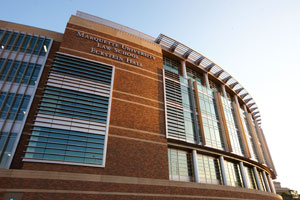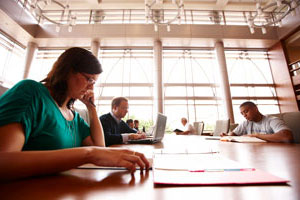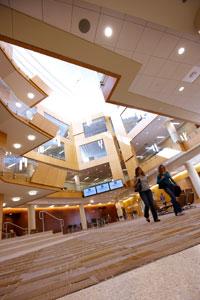
Eckstein Hall, the new home of Marquette University Law School, officially opened for students last month. Photos by: Ben Smidt, Marquette University
Sept. 1, 2010 – Marquette University Law School Dean Joseph Kearney wanted a law school that blended traditional aspects of legal education with a 21st century twist. Kearney and those involved with the newly minted law school building got both.
On Sept. 8, a formal ceremony will dedicate the newly constructed Eckstein Hall, an impressive four-story, 200,000 sq. ft. facility decked with state-of-the art technology that promotes learning through traditional study and interaction with other students and faculty, while providing more tools and resources to gain practical skills.
The building also supports the school’s public policy outreach goals as the “other Marquette Interchange,” which refers to the law school’s interest in hosting an “interchange” of law and policy speakers, lectures, conferences and debates that Sensenbrenner Hall, the former law school building, could not support.
“Our goal became nothing less than to construct the best law school building in the country, a very lofty goal, and we realized it,” Dean Kearney said.
Dean Kearney also hoped to create a law school culture that encourages students to remain within the walls of Eckstein Hall during their law school career.
“A law school, at its best, is a destination to which students go in the morning and do not wish to leave,” Dean Kearney said. As “part of the immersive nature of a law school education … we wanted to provide the amenities to make the law school feel like home.”
With a full-service café, closet-sized lockers, a workout area, and a grand reading room with fireplace, students will certainly feel at “home” in Eckstein Hall, which overlooks the Marquette Interchange on the edge of campus at 1215 W. Michigan St.
But with advanced technology to enhance course management tools in 11 classrooms, a “library without borders,” and broadcasting capability in one of two courtrooms, Eckstein Hall will likely be a thinking “epicenter” for more than just students.
In fact, Eckstein Hall touted its broadcasting capability Aug. 25, the first week of classes, by hosting a town hall meeting-style debate between Republican gubernatorial candidates Mark Neumann and Scott Walker that aired statewide on WISN-TV from its appellate courtroom.
A mix of modern, interactive, and traditional law study

Students in the Aitken Reading Room, a two-story room named for Marquette Law alumnus Wylie Aitken, a California attorney, and his wife Bette. The room overlooks downtown Milwaukee and the Marquette Interchange freeway.
With its new building, Marquette Law School takes the next step in recognizing the evolving practice of law. At Eckstein Hall, the traditional mode of study – the quiet study of law – combines with a modern focus on practical skills through interaction and technology.
Patricia Cervenka, Marquette law professor and law library director, calls the new facility “one of the best law schools in the country, without question.” Matthew Parlow, law professor and associate dean of academic affairs, describes it as a “vibrant and energized” place.
Funded largely by a $51 million gift from alumni Ray and Kay Eckstein, a $5 million gift by philanthropist Joseph Zilber, and $1 million gift by the Bradley Foundation – Eckstein Hall caters to law students, faculty, and the Milwaukee legal community.
Zilber Forum, a four-story atrium-style space in the center of the law school, serves as a gathering place for students and faculty. The forum, surrounded by the sycamore wood that dominates the school’s inner structure, is designed to encourage student and faculty interaction outside the classroom, and to foster a sense of legal community within the building.
“Much of a student’s learning takes place outside the classroom,” Professor Parlow said. “The forum is a place where energy sort of draws in from everywhere and really encourages students and faculty to interact in a vibrant and energized setting.”
The law library, which spans all four floors of Eckstein Hall, opens up to the forum and serves the concept of a “library without borders.” That is, the library is not restricted by walls on all sides, and uses space to make the law school and law library one and the same.
Professor Cervenka agrees that the new law school and library embrace changes in technology while respecting the traditional aspects of law school education.
For instance, the Aitken reading room, a two-story space dominated by cherry wood, a wall of windows and a stone fireplace, provides a quiet and comfortable space for traditional study. Dean Kearney said the reading room, his favorite spot, will help students develop a foundational aspect of law study – reading.
“In a building as modern and social as the one we have created, it is very important that we communicate to students that there is only so much they can learn without developing a habit of reading,” Dean Kearney said.

Zilber Forum, a grand four-story atrium at the heart of the building named for law school alumnus and Milwaukee builder Joe Zilber.
To highlight this aspect of study, the law school has commissioned a painting that will depict an 1859 speech delivered by Abraham Lincoln in Milwaukee addressing the importance of reading. The painting will hang in the Aiken reading room.
Grounded in the principles of law, the adversity of Eckstein Hall will also allow students to test their practical skills, interact, and gain access to other learning tools.
Two courtrooms, a 5,000-sq. ft., 200-person capacity appellate courtroom and a smaller trial courtroom, incorporate advanced audio and video technology, such as nonintrusive cameras, to help students gain practical training in modern day trial practice. The courtrooms will also accommodate visiting courts that chose to sit for official court proceedings.
The 11 classrooms positioned on all four floors incorporate collaborative seating, advanced technology, and distance learning capacity to give professors better course management tools.
“The different types of classrooms allow professors to be in classrooms that work for the types of classes they are teaching,” Professor Parlow said. “More and more, law schools are focusing on skill-building. These types of spaces allow for these varied learning environments.”
A large conference center on the fourth floor, bordered by a terrace-style space with outdoor access, can be divided by drop-down walls. Dean Kearney said the conference center will help the law school “keep the law school’s work in the law school building.” That is, where Sensenbrenner Hall could not support conferences and other events, Eckstein Hall will.
And while Eckstein Hall embraces the space and technology that its predecessor could no longer accommodate, the new law school carries the tradition of the old.
Upon completion of Sensenbrenner Hall in 1924, Marquette Law Review’s editor-in-chief wrote: “With the erection of this building, a great milestone in the progress of the Marquette Law School is passed and the state of Wisconsin can point with pride to an institution which maintains an ideal place for a student to pursue a knowledge of the law.”
Eighty-six years later, the same words can describe Eckstein Hall, which also represents a great milestone in the progress of Marquette Law School.
Related: The new home of Marquette University Law School (video)
